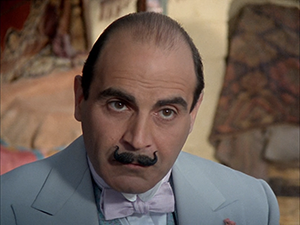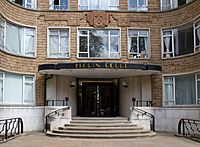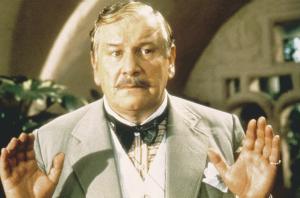Hercule Poirot facts for kids
Quick facts for kids Hercule Poirot |
|
|---|---|

David Suchet as Hercule Poirot in Agatha Christie's Poirot
|
|
| First appearance | The Mysterious Affair at Styles (1920) |
| Last appearance | Curtain (1975) |
| Created by | Agatha Christie |
| Portrayed by | Charles Laughton Francis L. Sullivan Austin Trevor Orson Welles Harold Huber Richard Williams John Malkovich José Ferrer Martin Gabel Tony Randall Albert Finney Dudley Jones Peter Ustinov Ian Holm David Suchet John Moffatt Maurice Denham Peter Sallis Konstantin Raikin Alfred Molina Robert Powell Jason Durr Kenneth Branagh Anthony O'Donnell Shirō Itō (Takashi Akafuji) Mansai Nomura (Takeru Suguro) Tom Conti |
| Voiced by | Kōtarō Satomi |
| Information | |
| Gender | Male |
| Occupation | Private investigator Police officer (former occupation) |
| Family | Jules-Louis Poirot (father) Godelieve Poirot (mother) |
| Religion | Catholic |
| Nationality | Belgian |
| Birth date and place | c. 1873–1883 Spa, Wallonia, Belgium |
| Death date and place | c. 1972–1975 Styles St. Mary, England |
Hercule Poirot is a famous fictional detective from Belgium. He was created by the British writer Agatha Christie. Poirot is one of Christie's most well-known characters. He appeared in 33 novels, two plays, and over 50 short stories. These stories were published between 1920 and 1975.
Many actors have played Poirot in movies, on TV, and on the radio. Some famous actors include David Suchet, Albert Finney, and Kenneth Branagh.
Who is Hercule Poirot?
How Poirot was Created
Agatha Christie got ideas for Poirot from other detectives in books. His name sounds like "Hercule Popeau" and "Monsieur Poiret." Christie also said she was inspired by the famous detective Sherlock Holmes. Poirot has a helper, Captain Hastings, much like Holmes has Dr. Watson.
Christie wrote her first Poirot book in 1916. It was published in 1920. Poirot was a Belgian refugee in England during World War I. This explained why a skilled detective was available to solve mysteries there. At that time, people in Britain felt sympathy for Belgians. This was because Germany had invaded Belgium, which led Britain to join the war.
Why Poirot was Popular
Poirot first appeared in the book The Mysterious Affair at Styles in 1920. He made his last appearance in Curtain in 1975. After Curtain was published, Poirot was the only fictional character to have an obituary (a death notice) on the front page of The New York Times newspaper.
Agatha Christie herself sometimes found Poirot annoying. She called him "detestable" and "tiresome." But Poirot was very popular with readers. Christie felt it was her duty to keep writing about him because people loved him so much.
Poirot's Look and Habits
Captain Arthur Hastings described Poirot as a small man, about five feet four inches tall. He carried himself with great dignity. His head was shaped like an egg, and he often tilted it to one side. He had a very stiff, military-looking moustache.
Poirot was incredibly neat. A tiny speck of dust would bother him more than an injury. He had green eyes that would shine "like a cat's" when he had a clever idea. He also dyed his dark hair later in life. In some movies, he is shown as bald.
He often wore shiny patent leather shoes. If they got damaged, it would make him very upset. Poirot's style of dress, which was fashionable when he was young, later became very old-fashioned.
Poirot was also very particular about food. He had a sensitive stomach. He was always on time and carried a pocket watch. He liked to keep his bank account balance at exactly 444 pounds, 4 shillings, and 4 pence. Some people think he might have had OCD because of his habits. He also enjoyed classical music, especially by Mozart and Bach.
How Poirot Solved Cases
In his early cases, Poirot was a traditional detective. He looked for clues and used logic. He often talked about using his "little grey cells" (his brain) and having "order and method." Sometimes, he would keep important details secret from his friends, like Hastings.
Later, Poirot focused more on understanding people's minds. Instead of just looking for clues at a crime scene, he would learn about the victim or the killer's personality. He believed that certain types of people commit certain crimes.
Poirot was very good at getting people to talk. He would sometimes act like a kind "Papa Poirot" to young women. He also sometimes gave false information about himself to get people to open up. For example, he might pretend to have a sick relative to ask questions about hospitals. He also liked to talk about himself in the third person, saying "Poirot will do this" instead of "I will do this." He sometimes acted more foreign or vain so people would underestimate him.
In the end, Poirot would gather all the suspects in a room. He would then explain how the crime happened and who did it, using his clever deductions.
Poirot's Life Story
Where Poirot Came From
Agatha Christie did not give many details about Poirot's early life. She imagined him as an old man even in his first books. She didn't know she would write about him for decades!
It is thought that Poirot was born near the town of Spa, Belgium. There's a small village called Ellezelles in Belgium that also claims to be his birthplace. They even have a copy of a "birth certificate" for him, naming his parents as Jules-Louis and Godelieve Poirot.
Christie wrote that Poirot was born a Catholic. He came from a large family but was not wealthy. He could speak French, English, and German.
Poirot as a Policeman
Hercule Poirot worked for the police force in Brussels, Belgium, starting around 1893. During his police career, he once shot a man who was firing at people from a roof. He also learned to read writing upside down! He met Xavier Bouc, who was the director of a famous train company.
Poirot was the Chief of Police of Brussels. But World War I forced him to leave Belgium and go to England.
Poirot as a Private Detective
During World War I, Poirot came to England as a refugee. On July 16, 1916, he met his good friend, Captain Arthur Hastings, again. He then solved his first published case, The Mysterious Affair at Styles.
After this case, the British secret service noticed Poirot's skills. He even helped the British government, like stopping an attempt to kidnap the Prime Minister. The British authorities learned about his detective abilities from the Belgian royal family.


After the war, Poirot became a private detective. He moved into Flat 203 at 56B Whitehaven Mansions, which was both his home and office. His first case as a private detective was "The Affair at the Victory Ball." This case helped him become known in high society.
Between the two World Wars, Poirot traveled a lot. He went all over Europe and the Middle East, solving many crimes. This was when he was at his best as a detective. He usually avoided traveling by sea because he got seasick.
During this time, he met Countess Vera Rossakoff, a charming jewel thief. Poirot was quite taken with her and even let her escape justice once.
Poirot usually got paid well for his cases. But he would also take on cases that interested him, even if they didn't pay much. He loved steam trains, which was different from Hastings, who loved cars. Steam trains appear in many of his stories.
Poirot's Retirement
Poirot tried to retire several times, but he never truly stopped solving mysteries. He didn't enjoy retirement much. His curiosity would always lead him to take on new cases. He even kept his secretary, Miss Lemon, working for him in the 1950s. So, Christie didn't give a clear timeline for his retirement. He could be an active, consulting, or retired detective depending on the story.
Poirot's Later Life
Towards the end of his career, Poirot was less active. He spent his time studying old unsolved cases and reading detective novels. He even wrote a book about mystery fiction. He would solve small, everyday puzzles, like why there were three pieces of orange peel in his umbrella stand.
His appearance also changed a lot. When Captain Hastings met him again in Curtain, Poirot had become thin and his hair was clearly dyed.
Poirot's Death
In the ITV television series, Poirot died in October 1949 from a heart condition. This happened at Styles Court, the same place where he solved his first English case in 1916. In Christie's books, he lived into the early 1970s.
In his last case, Curtain, Poirot was the murderer. He moved his heart medication out of reach, possibly because he felt guilty. He killed someone to prevent them from committing more murders. Poirot wanted to die soon after his final act. He worried that if he lived, he might become arrogant and think he had the right to decide who should die.
Poirot's actual death and funeral happened in Curtain. But it wasn't the first time Hastings attended his funeral! In The Big Four (1927), Poirot faked his own death to surprise a group of criminals.
Friends and Helpers
- Captain Arthur Hastings - A former British Army officer and Poirot's lifelong friend. He appears in many cases. Hastings is loyal but sometimes a bit naive. He is like Dr. Watson to Sherlock Holmes.
- Mrs. Ariadne Oliver - A detective novelist. She is often seen as Agatha Christie's funny version of herself. She met Poirot in Cards on the Table and often gets involved in his cases.
- Miss Felicity Lemon - Poirot's very efficient secretary. She sometimes helps Poirot with his investigations.
- Chief Inspector James Harold Japp - A Scotland Yard Inspector. He appears in many stories, often working on the same cases as Poirot. Poirot often helps Japp and lets him take the credit.
Famous Poirot Books
The Poirot books show his whole life in England. From his first book, The Mysterious Affair at Styles, where he is a refugee, to his last, Curtain, where he returns to Styles before his death. Poirot also solves cases outside England, like his most famous one, Murder on the Orient Express (1934).
Some of his most famous books include:
- The Murder of Roger Ackroyd (1926)
- Murder on the Orient Express (1934)
- The ABC Murders (1935)
- Cards on the Table (1936)
- Death on the Nile (1937)
- Five Little Pigs (also known as Murder in Retrospect) (1942)
In 2014, a new Poirot novel was written by Sophie Hannah. It was called The Monogram Murders. This was the first new Poirot story approved by Christie's family. It was set in the late 1920s. Sophie Hannah wrote two more Poirot books: Closed Casket (2016) and The Mystery of Three Quarters (2018).
Poirot in Movies and TV
On Stage
- Charles Laughton played Poirot in the play Alibi in 1928.
- Francis L. Sullivan played him in Black Coffee in 1930.
In Films
Austin Trevor
Austin Trevor was the first actor to play Poirot in a movie. This was in the 1931 British film Alibi. He played Poirot two more times. Trevor said he was chosen because he could do a French accent. Interestingly, his Poirot did not have a moustache!
Tony Randall
Tony Randall played Poirot in The Alphabet Murders (1965). This movie was more of a comedy and very different from the original book.
Albert Finney

Albert Finney played Poirot in the 1974 movie Murder on the Orient Express. He was nominated for an Academy Award for his role.
Peter Ustinov

Peter Ustinov played Poirot six times. He started with Death on the Nile (1978). He also played him in Evil Under the Sun (1982) and Appointment with Death (1988).
Christie's daughter, Rosalind Hicks, once saw Ustinov rehearsing. She said, "That's not Poirot!" Ustinov heard her and replied, "He is now!"
Ustinov also played Poirot in three TV movies. These movies were set in modern times, not the past. In one of them, Thirteen at Dinner (1985), David Suchet (who later became a famous Poirot) played Inspector Japp!
Kenneth Branagh
Kenneth Branagh played Poirot in the movies Murder on the Orient Express (2017) and Death on the Nile (2022). He also directed both films. He is set to play Poirot again in a third movie.
On Television
David Suchet
David Suchet is perhaps the most famous actor to play Poirot. He starred in the ITV series Agatha Christie's Poirot from 1989 to 2013. He played Poirot in every single story written by Agatha Christie, including all 33 novels and many short stories. His final appearance was in Curtain: Poirot's Last Case in 2013. Many people consider Suchet to be the "Best Poirot."
The show was filmed in many places in the UK and other countries.
In Anime
In 2004, a Japanese TV network (NHK) made an anime series called Agatha Christie's Great Detectives Poirot and Marple. It had 39 episodes and adapted many Poirot and Miss Marple stories.
On Radio
From 1985 to 2007, BBC Radio 4 made many radio adaptations of Poirot novels. John Moffatt played Poirot in most of these.
In 1939, Orson Welles also did a radio play of The Murder of Roger Ackroyd.
In Video Games
Poirot appears in the game Agatha Christie - Hercule Poirot: The First Cases.
See also
 In Spanish: Hércules Poirot para niños
In Spanish: Hércules Poirot para niños


